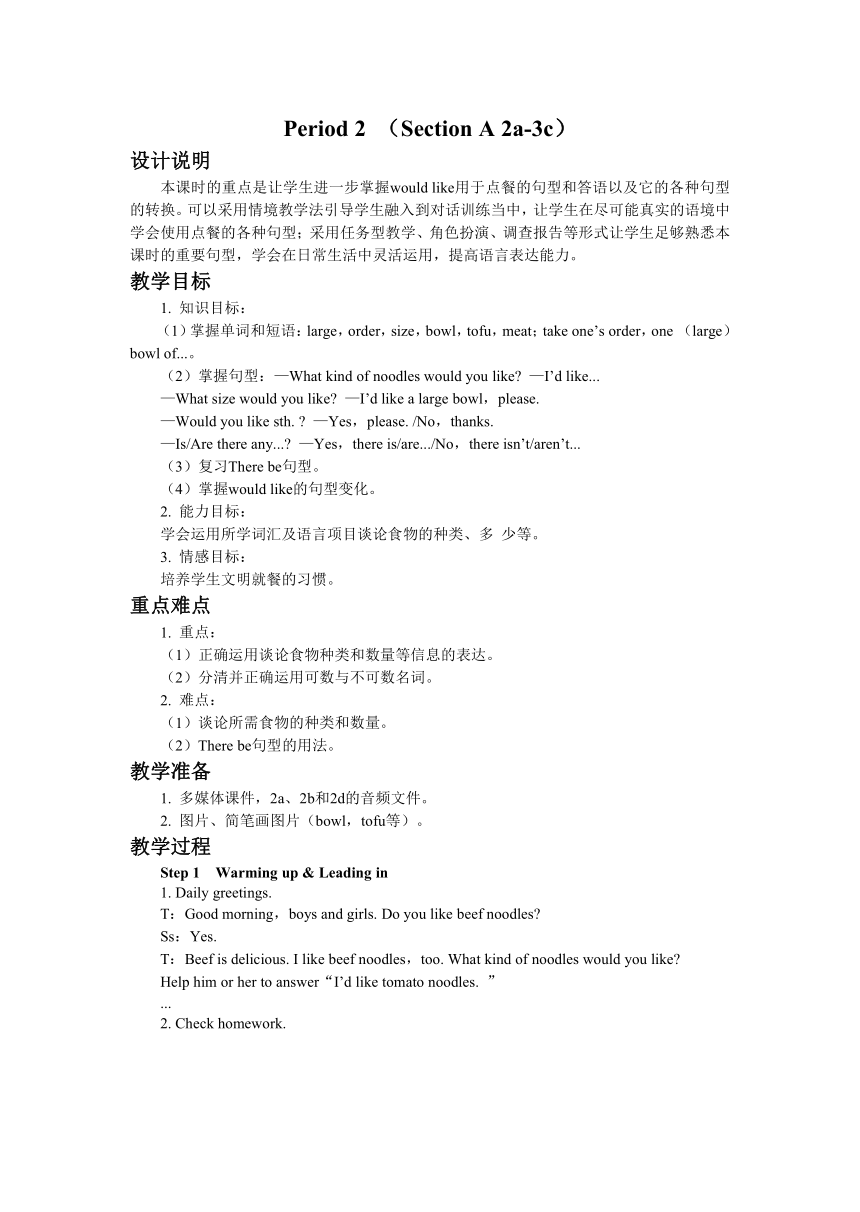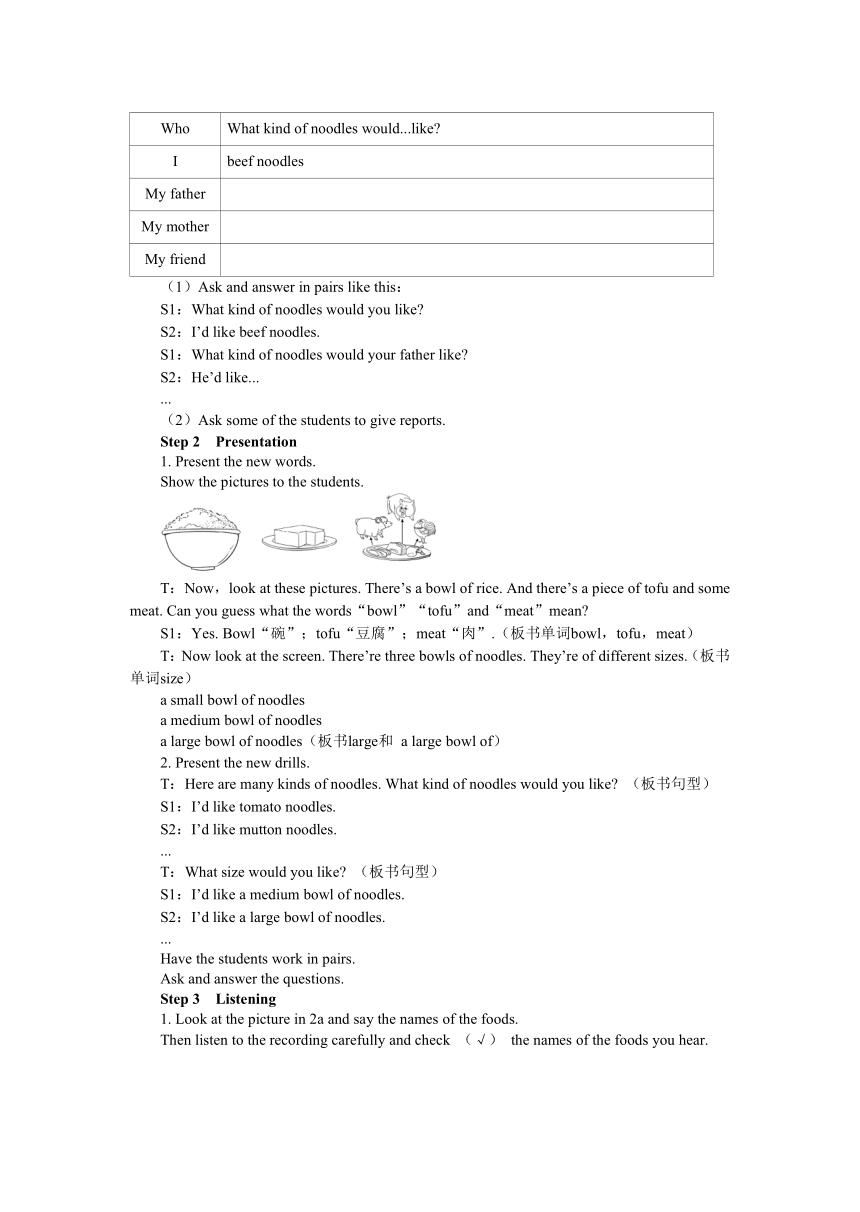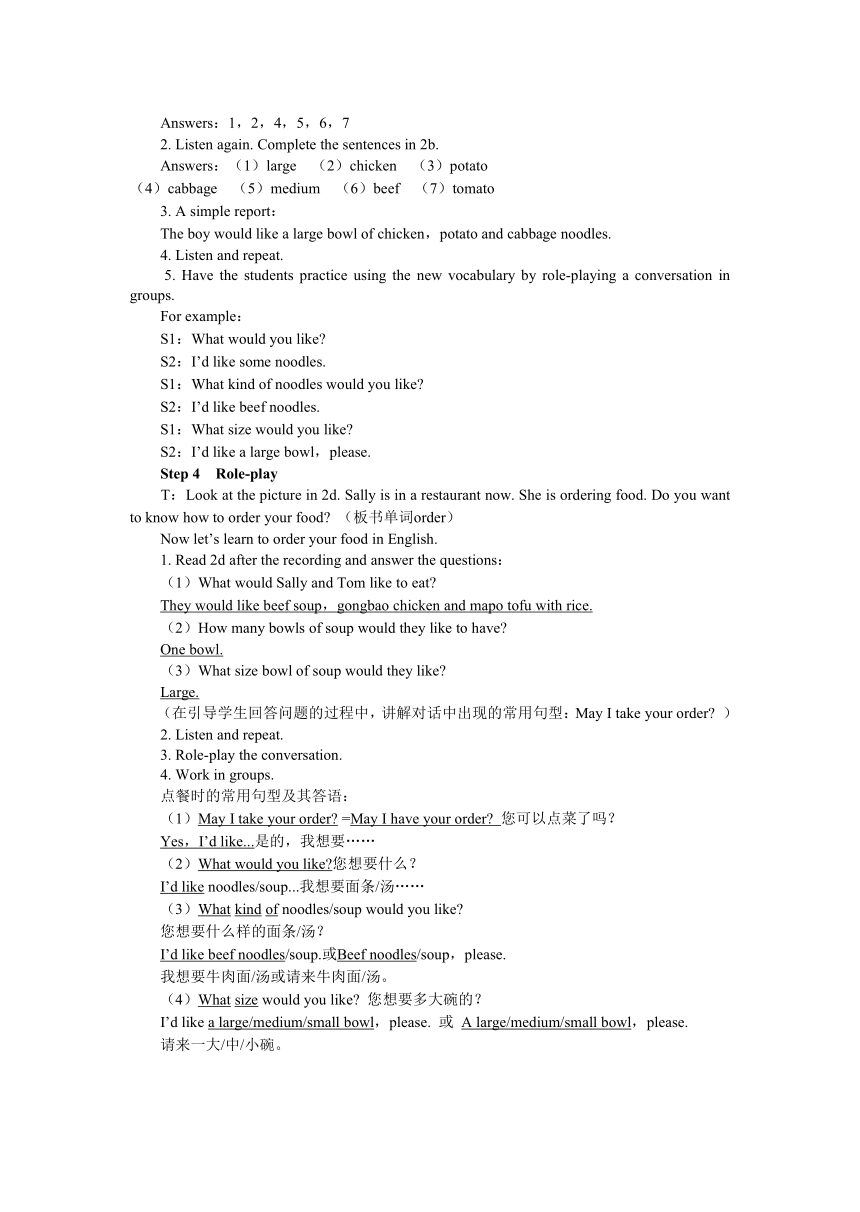Unit 10 I'd like some noodles. Period 2 (Section A 2a-3c)-教案
文档属性
| 名称 | Unit 10 I'd like some noodles. Period 2 (Section A 2a-3c)-教案 |  | |
| 格式 | docx | ||
| 文件大小 | 122.8KB | ||
| 资源类型 | 教案 | ||
| 版本资源 | 人教新目标(Go for it)版 | ||
| 科目 | 英语 | ||
| 更新时间 | 2022-04-30 15:31:31 | ||
图片预览



文档简介
Period 2 (Section A 2a-3c)
设计说明
本课时的重点是让学生进一步掌握would like用于点餐的句型和答语以及它的各种句型的转换。可以采用情境教学法引导学生融入到对话训练当中,让学生在尽可能真实的语境中学会使用点餐的各种句型;采用任务型教学、角色扮演、调查报告等形式让学生足够熟悉本课时的重要句型,学会在日常生活中灵活运用,提高语言表达能力。
教学目标
1. 知识目标:
(1)掌握单词和短语:large,order,size,bowl,tofu,meat;take one’s order,one (large) bowl of...。
(2)掌握句型:—What kind of noodles would you like —I’d like...
—What size would you like —I’d like a large bowl,please.
—Would you like sth. —Yes,please. /No,thanks.
—Is/Are there any... —Yes,there is/are.../No,there isn’t/aren’t...
(3)复习There be句型。
(4)掌握would like的句型变化。
2. 能力目标:
学会运用所学词汇及语言项目谈论食物的种类、多 少等。
3. 情感目标:
培养学生文明就餐的习惯。
重点难点
1. 重点:
(1)正确运用谈论食物种类和数量等信息的表达。
(2)分清并正确运用可数与不可数名词。
2. 难点:
(1)谈论所需食物的种类和数量。
(2)There be句型的用法。
教学准备
1. 多媒体课件,2a、2b和2d的音频文件。
2. 图片、简笔画图片(bowl,tofu等)。
教学过程
Step 1 Warming up & Leading in
1. Daily greetings.
T:Good morning,boys and girls. Do you like beef noodles
Ss:Yes.
T:Beef is delicious. I like beef noodles,too. What kind of noodles would you like
Help him or her to answer“I’d like tomato noodles. ”
...
2. Check homework.
Who What kind of noodles would...like
I beef noodles
My father
My mother
My friend
(1)Ask and answer in pairs like this:
S1:What kind of noodles would you like
S2:I’d like beef noodles.
S1:What kind of noodles would your father like
S2:He’d like...
...
(2)Ask some of the students to give reports.
Step 2 Presentation
1. Present the new words.
Show the pictures to the students.
T:Now,look at these pictures. There’s a bowl of rice. And there’s a piece of tofu and some meat. Can you guess what the words“bowl”“tofu”and“meat”mean
S1:Yes. Bowl“碗”;tofu“豆腐”;meat“肉”.(板书单词bowl,tofu,meat)
T:Now look at the screen. There’re three bowls of noodles. They’re of different sizes.(板书单词size)
a small bowl of noodles
a medium bowl of noodles
a large bowl of noodles(板书large和 a large bowl of)
2. Present the new drills.
T:Here are many kinds of noodles. What kind of noodles would you like (板书句型)
S1:I’d like tomato noodles.
S2:I’d like mutton noodles.
...
T:What size would you like (板书句型)
S1:I’d like a medium bowl of noodles.
S2:I’d like a large bowl of noodles.
...
Have the students work in pairs.
Ask and answer the questions.
Step 3 Listening
1. Look at the picture in 2a and say the names of the foods.
Then listen to the recording carefully and check (√) the names of the foods you hear.
Answers:1,2,4,5,6,7
2. Listen again. Complete the sentences in 2b.
Answers:(1)large (2)chicken (3)potato
(4)cabbage (5)medium (6)beef (7)tomato
3. A simple report:
The boy would like a large bowl of chicken,potato and cabbage noodles.
4. Listen and repeat.
5. Have the students practice using the new vocabulary by role-playing a conversation in groups.
For example:
S1:What would you like
S2:I’d like some noodles.
S1:What kind of noodles would you like
S2:I’d like beef noodles.
S1:What size would you like
S2:I’d like a large bowl,please.
Step 4 Role-play
T:Look at the picture in 2d. Sally is in a restaurant now. She is ordering food. Do you want to know how to order your food (板书单词order)
Now let’s learn to order your food in English.
1. Read 2d after the recording and answer the questions:
(1)What would Sally and Tom like to eat
They would like beef soup,gongbao chicken and mapo tofu with rice.
(2)How many bowls of soup would they like to have
One bowl.
(3)What size bowl of soup would they like
Large.
(在引导学生回答问题的过程中,讲解对话中出现的常用句型:May I take your order )
2. Listen and repeat.
3. Role-play the conversation.
4. Work in groups.
点餐时的常用句型及其答语:
(1)May I take your order =May I have your order 您可以点菜了吗?
Yes,I’d like...是的,我想要……
(2)What would you like 您想要什么?
I’d like noodles/soup...我想要面条/汤……
(3)What kind of noodles/soup would you like
您想要什么样的面条/汤?
I’d like beef noodles/soup.或Beef noodles/soup,please.
我想要牛肉面/汤或请来牛肉面/汤。
(4)What size would you like 您想要多大碗的?
I’d like a large/medium/small bowl,please. 或 A large/medium/small bowl,please.
请来一大/中/小碗。
(5)Here’s the menu. 给您菜单。
(6)May I have the menu,please
我可以看一下菜单吗?
Sure. Here you are. /Here it is.
当然,给您/在这里。
(7)I’d like to order...我想点……
Step 5 Grammar Focus
1. Read the sentences in Grammar Focus.
2. Sum up the grammar points:
(1)would like的句型变化:
肯定句:S(主)+would like sth.
否定句:S(主)+would not like sth.
一般疑问句:Would + S(主)+like sth.
肯定回答:Yes,please.
否定回答:No,thanks.
(2)名词的数:可数名词与不可数名词
Write down the countable nouns and uncountable nouns you remember.
Countable nouns:bowl,noodle,potato,special,apple, carrot
Uncountable nouns:beef,mutton,meat,milk,water
Countable and uncountable nouns:chicken(鸡;鸡肉),fish(鱼;鱼肉),orange(橙子;橙汁),cabbage,onion
(3)Revise“There be”.
There be句型用法口诀:
There be句型有特点,主语放在be后边。
单数主语用is,复数主语要用 are。
变否定很简单,be后要把 not添。
变问句也不难,把 be提到there前。
肯定句中用some,否定/疑问 any换。
Step 6 Practice
1. Look at plete the conversation within two or three minutes. Then check the answers.
Answers:2. a 3. f 4. c 5. e 6. b
2. Look at 3b. Write questions and answers using the words in brackets.
Check their answers. (可通过朗读、学生板书或投影等方式检查)
Answers:1. I’d like chicken and beef noodles with tomatoes.
2. What size would you like
I’d like a medium bowl,please.
3. Is there any cabbage in the beef noodles
No,there isn’t any. /No,there is no cabbage.
3. T:Look at the pictures in 3c. Now work in small groups. Find out “Who would like the food below ”. You can do it like this:
A:Anna,what would you like to eat
B:I’d like beef noodles with carrots.
4. (After several minutes)Have some students report like this:Anna would like beef noodles with carrots. Sally would like...
Step 7 Summary
In this lesson,we have learned:
1. New words:large,order,size,bowl,tofu,meat
2. Phrases:take one’s order,one (large) bowl of...
3. Sentence structures:
—What kind of noodles would you like —I’d like...
—What size would you like —I’d like a large bowl,please.
—Would you like sth. —Yes,please. /No,thanks.
—Is/Are there any... —Yes,there is/are.../No,there isn’t/aren’t...
当堂达标(见导学案“当堂达标”)
答案与解析:
Ⅰ. 1. B 根据答语可知,上句询问面条的“种类”。
2. D meat为不可数名词,be动词应用is;tomato作定语修饰名词时应用单数形式。
3. A 空格前的much用来修饰不可数名词,选项中bread是不可数名词。句意:我一点儿也不饿,因为我刚才吃了很多面包。
4. A 根据答语“我想要一大碗”可知,问句意为“你想要多大碗的汤?”。what size符合题意。
5. B 由答语“我想要些水饺和一杯果汁”可知,该题的语言情景是在餐馆点餐,“您可以点餐了吗?”符合语境。故选B。
Ⅱ. 1. What kind,do,want what kind of 是固定搭配,意为“什么样的,什么种类的”。want为实义动词,you为第二人称,故助动词用do。
2. a/one large bowl,tomato,egg a/one large bowl of 是固定短语,意为“一大碗……”;“西红柿鸡蛋面”中的西红柿(tomato)和鸡蛋(egg)作定语修饰noodles,tomato和egg都用单数形式。
3. mutton,potato 此处mutton和potato作定语修饰noodles,当一个名词在另一个名词前充当定语时,起修饰作用的名词常用单数形式。
4. May,take your order 点餐时,“May I take your order ”是一个固定句型。
5. Is there,vegetable soup there be句型意为“有……”, meat是不可数名词,be动词用is,一般疑问句应将be动词is提前。vegetable soup意为“蔬菜汤”。
Ⅲ. 1. What would,like 对物提问用what,疑问句把would提前,like仍用动词原形。
2. Would,like would是情态动词,变一般疑问句时,将它提前。
3. What kind,would,like 对种类提问用what kind,疑问句把would提前,like仍用动词原形。
4. would like want相当于would like,意为“想要”。
5. What size,would 对“大小、尺码”提问用what size,变疑问句时把would提前。
6. No,thanks
7. Are there any;there aren’t there be句型变一般疑问句时将be动词提到句首,疑问句中应将some改为any。there be句型的否定答语是“No,there be not. ”。
8. is no
Ⅳ. 1. B 由下文可知此处应填表示“种类”的词,how many后跟可数名词复数形式,故选B。
2. C would like to do sth. 意为“想要做某事”。
3. D 由下文中的Special 2可知选D。
4. D 主语是all of them,表示所有种类的面条,故be动词用are。
5. B 由下文可知是介绍饺子,故用dumplings。
6. A know为实义动词,后面的人称代词应用宾格形式;此处用them代指前面的dumplings。
7. C 由后面的noodles and fried dumplings可知,此处指两种中国特色食物。
8. D 此处表示转折,引入另外一种饺子,故选D。
9. A 由句意“我们经常在春节期间吃水煮的饺子”可知选A。during意为“在……期间”。
10. B 句意:我希望你(们)也喜欢它。too“也”,用于肯定句句末;also“也”,用于肯定句句中,位于实义动词之前,助动词、连系动词be及情态动词之后;either“也(不)”,用于否定句句末;very“非常”,不合题意。故选B。
Ⅴ. 1. E 根据答语“好的。我想要一碗西红杮鸡蛋面”可知,所缺的句子是E。
2. A 根据答语“那么我就要一碗羊肉土豆面吧”可知,所缺的句子是A,该句意为“我们今天没有鸡蛋”。
3. D 根据设空后的“我们有鸡肉卷心菜面和牛肉胡萝卜面”可推断,所缺的问句是D,该句意为“你们有什么种类的面条?”。
4. F 根据上下文的描述可知,说话人B点了碗鸡肉卷心菜面,故所缺的句子是F。
5. B 根据问句“你想要多大碗的?”可推断,所缺的句子是B。
Step 8 Homework
1. Remember the useful expressions in 2d and Grammar Focus.
2. Read and role-play the conversations in 2d and 3a.
3. Prepare Section B 1a-1d before class.
板书设计
UNIT 10 I’d like some noodles. Period 2(Section A 2a-3c)
phrases:take one’s order,one(large)bowl of... —What kind of noodles would you like —I’d like... —What size would you like —I’d like a medium/large/small bowl,please. —Would you like sth. —Yes,please. /No,thanks. —Are there any...
教学反思
设计说明
本课时的重点是让学生进一步掌握would like用于点餐的句型和答语以及它的各种句型的转换。可以采用情境教学法引导学生融入到对话训练当中,让学生在尽可能真实的语境中学会使用点餐的各种句型;采用任务型教学、角色扮演、调查报告等形式让学生足够熟悉本课时的重要句型,学会在日常生活中灵活运用,提高语言表达能力。
教学目标
1. 知识目标:
(1)掌握单词和短语:large,order,size,bowl,tofu,meat;take one’s order,one (large) bowl of...。
(2)掌握句型:—What kind of noodles would you like —I’d like...
—What size would you like —I’d like a large bowl,please.
—Would you like sth. —Yes,please. /No,thanks.
—Is/Are there any... —Yes,there is/are.../No,there isn’t/aren’t...
(3)复习There be句型。
(4)掌握would like的句型变化。
2. 能力目标:
学会运用所学词汇及语言项目谈论食物的种类、多 少等。
3. 情感目标:
培养学生文明就餐的习惯。
重点难点
1. 重点:
(1)正确运用谈论食物种类和数量等信息的表达。
(2)分清并正确运用可数与不可数名词。
2. 难点:
(1)谈论所需食物的种类和数量。
(2)There be句型的用法。
教学准备
1. 多媒体课件,2a、2b和2d的音频文件。
2. 图片、简笔画图片(bowl,tofu等)。
教学过程
Step 1 Warming up & Leading in
1. Daily greetings.
T:Good morning,boys and girls. Do you like beef noodles
Ss:Yes.
T:Beef is delicious. I like beef noodles,too. What kind of noodles would you like
Help him or her to answer“I’d like tomato noodles. ”
...
2. Check homework.
Who What kind of noodles would...like
I beef noodles
My father
My mother
My friend
(1)Ask and answer in pairs like this:
S1:What kind of noodles would you like
S2:I’d like beef noodles.
S1:What kind of noodles would your father like
S2:He’d like...
...
(2)Ask some of the students to give reports.
Step 2 Presentation
1. Present the new words.
Show the pictures to the students.
T:Now,look at these pictures. There’s a bowl of rice. And there’s a piece of tofu and some meat. Can you guess what the words“bowl”“tofu”and“meat”mean
S1:Yes. Bowl“碗”;tofu“豆腐”;meat“肉”.(板书单词bowl,tofu,meat)
T:Now look at the screen. There’re three bowls of noodles. They’re of different sizes.(板书单词size)
a small bowl of noodles
a medium bowl of noodles
a large bowl of noodles(板书large和 a large bowl of)
2. Present the new drills.
T:Here are many kinds of noodles. What kind of noodles would you like (板书句型)
S1:I’d like tomato noodles.
S2:I’d like mutton noodles.
...
T:What size would you like (板书句型)
S1:I’d like a medium bowl of noodles.
S2:I’d like a large bowl of noodles.
...
Have the students work in pairs.
Ask and answer the questions.
Step 3 Listening
1. Look at the picture in 2a and say the names of the foods.
Then listen to the recording carefully and check (√) the names of the foods you hear.
Answers:1,2,4,5,6,7
2. Listen again. Complete the sentences in 2b.
Answers:(1)large (2)chicken (3)potato
(4)cabbage (5)medium (6)beef (7)tomato
3. A simple report:
The boy would like a large bowl of chicken,potato and cabbage noodles.
4. Listen and repeat.
5. Have the students practice using the new vocabulary by role-playing a conversation in groups.
For example:
S1:What would you like
S2:I’d like some noodles.
S1:What kind of noodles would you like
S2:I’d like beef noodles.
S1:What size would you like
S2:I’d like a large bowl,please.
Step 4 Role-play
T:Look at the picture in 2d. Sally is in a restaurant now. She is ordering food. Do you want to know how to order your food (板书单词order)
Now let’s learn to order your food in English.
1. Read 2d after the recording and answer the questions:
(1)What would Sally and Tom like to eat
They would like beef soup,gongbao chicken and mapo tofu with rice.
(2)How many bowls of soup would they like to have
One bowl.
(3)What size bowl of soup would they like
Large.
(在引导学生回答问题的过程中,讲解对话中出现的常用句型:May I take your order )
2. Listen and repeat.
3. Role-play the conversation.
4. Work in groups.
点餐时的常用句型及其答语:
(1)May I take your order =May I have your order 您可以点菜了吗?
Yes,I’d like...是的,我想要……
(2)What would you like 您想要什么?
I’d like noodles/soup...我想要面条/汤……
(3)What kind of noodles/soup would you like
您想要什么样的面条/汤?
I’d like beef noodles/soup.或Beef noodles/soup,please.
我想要牛肉面/汤或请来牛肉面/汤。
(4)What size would you like 您想要多大碗的?
I’d like a large/medium/small bowl,please. 或 A large/medium/small bowl,please.
请来一大/中/小碗。
(5)Here’s the menu. 给您菜单。
(6)May I have the menu,please
我可以看一下菜单吗?
Sure. Here you are. /Here it is.
当然,给您/在这里。
(7)I’d like to order...我想点……
Step 5 Grammar Focus
1. Read the sentences in Grammar Focus.
2. Sum up the grammar points:
(1)would like的句型变化:
肯定句:S(主)+would like sth.
否定句:S(主)+would not like sth.
一般疑问句:Would + S(主)+like sth.
肯定回答:Yes,please.
否定回答:No,thanks.
(2)名词的数:可数名词与不可数名词
Write down the countable nouns and uncountable nouns you remember.
Countable nouns:bowl,noodle,potato,special,apple, carrot
Uncountable nouns:beef,mutton,meat,milk,water
Countable and uncountable nouns:chicken(鸡;鸡肉),fish(鱼;鱼肉),orange(橙子;橙汁),cabbage,onion
(3)Revise“There be”.
There be句型用法口诀:
There be句型有特点,主语放在be后边。
单数主语用is,复数主语要用 are。
变否定很简单,be后要把 not添。
变问句也不难,把 be提到there前。
肯定句中用some,否定/疑问 any换。
Step 6 Practice
1. Look at plete the conversation within two or three minutes. Then check the answers.
Answers:2. a 3. f 4. c 5. e 6. b
2. Look at 3b. Write questions and answers using the words in brackets.
Check their answers. (可通过朗读、学生板书或投影等方式检查)
Answers:1. I’d like chicken and beef noodles with tomatoes.
2. What size would you like
I’d like a medium bowl,please.
3. Is there any cabbage in the beef noodles
No,there isn’t any. /No,there is no cabbage.
3. T:Look at the pictures in 3c. Now work in small groups. Find out “Who would like the food below ”. You can do it like this:
A:Anna,what would you like to eat
B:I’d like beef noodles with carrots.
4. (After several minutes)Have some students report like this:Anna would like beef noodles with carrots. Sally would like...
Step 7 Summary
In this lesson,we have learned:
1. New words:large,order,size,bowl,tofu,meat
2. Phrases:take one’s order,one (large) bowl of...
3. Sentence structures:
—What kind of noodles would you like —I’d like...
—What size would you like —I’d like a large bowl,please.
—Would you like sth. —Yes,please. /No,thanks.
—Is/Are there any... —Yes,there is/are.../No,there isn’t/aren’t...
当堂达标(见导学案“当堂达标”)
答案与解析:
Ⅰ. 1. B 根据答语可知,上句询问面条的“种类”。
2. D meat为不可数名词,be动词应用is;tomato作定语修饰名词时应用单数形式。
3. A 空格前的much用来修饰不可数名词,选项中bread是不可数名词。句意:我一点儿也不饿,因为我刚才吃了很多面包。
4. A 根据答语“我想要一大碗”可知,问句意为“你想要多大碗的汤?”。what size符合题意。
5. B 由答语“我想要些水饺和一杯果汁”可知,该题的语言情景是在餐馆点餐,“您可以点餐了吗?”符合语境。故选B。
Ⅱ. 1. What kind,do,want what kind of 是固定搭配,意为“什么样的,什么种类的”。want为实义动词,you为第二人称,故助动词用do。
2. a/one large bowl,tomato,egg a/one large bowl of 是固定短语,意为“一大碗……”;“西红柿鸡蛋面”中的西红柿(tomato)和鸡蛋(egg)作定语修饰noodles,tomato和egg都用单数形式。
3. mutton,potato 此处mutton和potato作定语修饰noodles,当一个名词在另一个名词前充当定语时,起修饰作用的名词常用单数形式。
4. May,take your order 点餐时,“May I take your order ”是一个固定句型。
5. Is there,vegetable soup there be句型意为“有……”, meat是不可数名词,be动词用is,一般疑问句应将be动词is提前。vegetable soup意为“蔬菜汤”。
Ⅲ. 1. What would,like 对物提问用what,疑问句把would提前,like仍用动词原形。
2. Would,like would是情态动词,变一般疑问句时,将它提前。
3. What kind,would,like 对种类提问用what kind,疑问句把would提前,like仍用动词原形。
4. would like want相当于would like,意为“想要”。
5. What size,would 对“大小、尺码”提问用what size,变疑问句时把would提前。
6. No,thanks
7. Are there any;there aren’t there be句型变一般疑问句时将be动词提到句首,疑问句中应将some改为any。there be句型的否定答语是“No,there be not. ”。
8. is no
Ⅳ. 1. B 由下文可知此处应填表示“种类”的词,how many后跟可数名词复数形式,故选B。
2. C would like to do sth. 意为“想要做某事”。
3. D 由下文中的Special 2可知选D。
4. D 主语是all of them,表示所有种类的面条,故be动词用are。
5. B 由下文可知是介绍饺子,故用dumplings。
6. A know为实义动词,后面的人称代词应用宾格形式;此处用them代指前面的dumplings。
7. C 由后面的noodles and fried dumplings可知,此处指两种中国特色食物。
8. D 此处表示转折,引入另外一种饺子,故选D。
9. A 由句意“我们经常在春节期间吃水煮的饺子”可知选A。during意为“在……期间”。
10. B 句意:我希望你(们)也喜欢它。too“也”,用于肯定句句末;also“也”,用于肯定句句中,位于实义动词之前,助动词、连系动词be及情态动词之后;either“也(不)”,用于否定句句末;very“非常”,不合题意。故选B。
Ⅴ. 1. E 根据答语“好的。我想要一碗西红杮鸡蛋面”可知,所缺的句子是E。
2. A 根据答语“那么我就要一碗羊肉土豆面吧”可知,所缺的句子是A,该句意为“我们今天没有鸡蛋”。
3. D 根据设空后的“我们有鸡肉卷心菜面和牛肉胡萝卜面”可推断,所缺的问句是D,该句意为“你们有什么种类的面条?”。
4. F 根据上下文的描述可知,说话人B点了碗鸡肉卷心菜面,故所缺的句子是F。
5. B 根据问句“你想要多大碗的?”可推断,所缺的句子是B。
Step 8 Homework
1. Remember the useful expressions in 2d and Grammar Focus.
2. Read and role-play the conversations in 2d and 3a.
3. Prepare Section B 1a-1d before class.
板书设计
UNIT 10 I’d like some noodles. Period 2(Section A 2a-3c)
phrases:take one’s order,one(large)bowl of... —What kind of noodles would you like —I’d like... —What size would you like —I’d like a medium/large/small bowl,please. —Would you like sth. —Yes,please. /No,thanks. —Are there any...
教学反思
同课章节目录
- Unit 1 Can you play the guitar?
- Section A
- Section B
- Unit 2 What time do you go to school?
- Section A
- Section B
- Unit 3 How do you get to school?
- Section A
- Section B
- Unit 4 Don't eat in class.
- Section A
- Section B
- Unit 5 Why do you like pandas?
- Section A
- Section B
- Unit 6 I'm watching TV.
- Section A
- Section B
- Review of Units 1-6
- Unit 7 It's raining!
- Section A
- Section B
- Unit 8 Is there a post office near here?
- Section A
- Section B
- Unit 9 What does he look like?
- Section A
- Section B
- Unit 10 I'd like some noodles.
- Section A
- Section B
- Unit 11 How was your school trip?
- Section A
- Section B
- Unit 12 What did you do last weekend?
- Section A
- Section B
